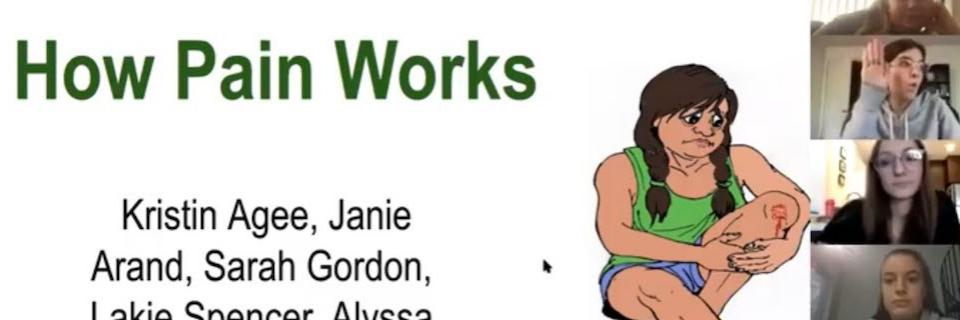PT Project Puts Pain Management in Perspective for Younger Audience

Pain is a fact of life. It’s a lesson many of us learn early on, with tears the stimulus response accompanying a scrape or a bump on the head.
But for many, pain is not simply temporary but a chronic or constant reality. And whatever form it takes, managing pain with medications often carries its own risks in the form of addiction.
It’s with that in mind that Debbie Rico, PT, DPT, assistant professor of physical therapy, gave students in her professional leadership and development course a special assignment — design a lesson for middle-school age students about healthy pain management. The approach is based on research on pain from the Therapeutic Neuroscience Research Group, and the project was designed to allow students to engage with communities around them, despite the pandemic.
In mid-October, several groups of physical therapy students delivered their presentations over video chat to students at St. Michael the Archangel School in Overland Park, Kansas, and Oakhill Day School in Gladstone, Missouri. Rico said the format — and the age group – meant the groups had to challenge themselves to make the information approachable and engaging. But talking to that middle-school age group is critical, according to Rico.
“This is the prime age, according to research,” she said. “Beliefs become really ingrained in our brain as we get older, so we want to make sure and teach these kids how to understand why they hurt. The research shows the more people understand the biology of pain, the less likely they will move on to chronic pain, including children.
Instead of being prescribed medication, Rico said it is important for younger students to have other tools – from sleep to movement— to use in dealing with pain. She said, physical therapists are uniquely positioned to offer alternative approaches to pain management.
“Exercise is movement, movement is medicine, movement is physical therapy,” Rico said. “Our bodies do a great job of healing themselves, and so this is about giving people the tools to let their bodies do that.”
Normally, these PT students would be taking part in face-to-face service learning opportunities, such as the fall prevention clinics held in the past, Rico said. Lakie Spencer, a DPT student, said the virtual nature did mean they had to find new ways to make an impact with the material. And, judging by the feedback, they did.
“We had them share what they learned following the presentation and so many students gained tons of knowledge on this very important topic that will be beneficial for them forever,” she said.
And in addition to sharing some lessons with those students, the PT students who participated said they learned plenty themselves, and not just about pain. For Kyle Ceriotti, a second year physical therapy student, crafting a lesson with her team was an opportunity to hone the communication skills she’ll rely on in her professional career.
“This fits in to the broader scope of our PT education by giving us training on communicating with variety of audiences,” she said. “The ability to craft our message to get the most out of our communications will be critical in our profession.”
Spencer said she came away with a new perspective on how she can use what she’s learned in service to others.
“I believe we all have a part in creating a successful community and sharing with others our specialty is just one way we can help others and grow together,” she said.







